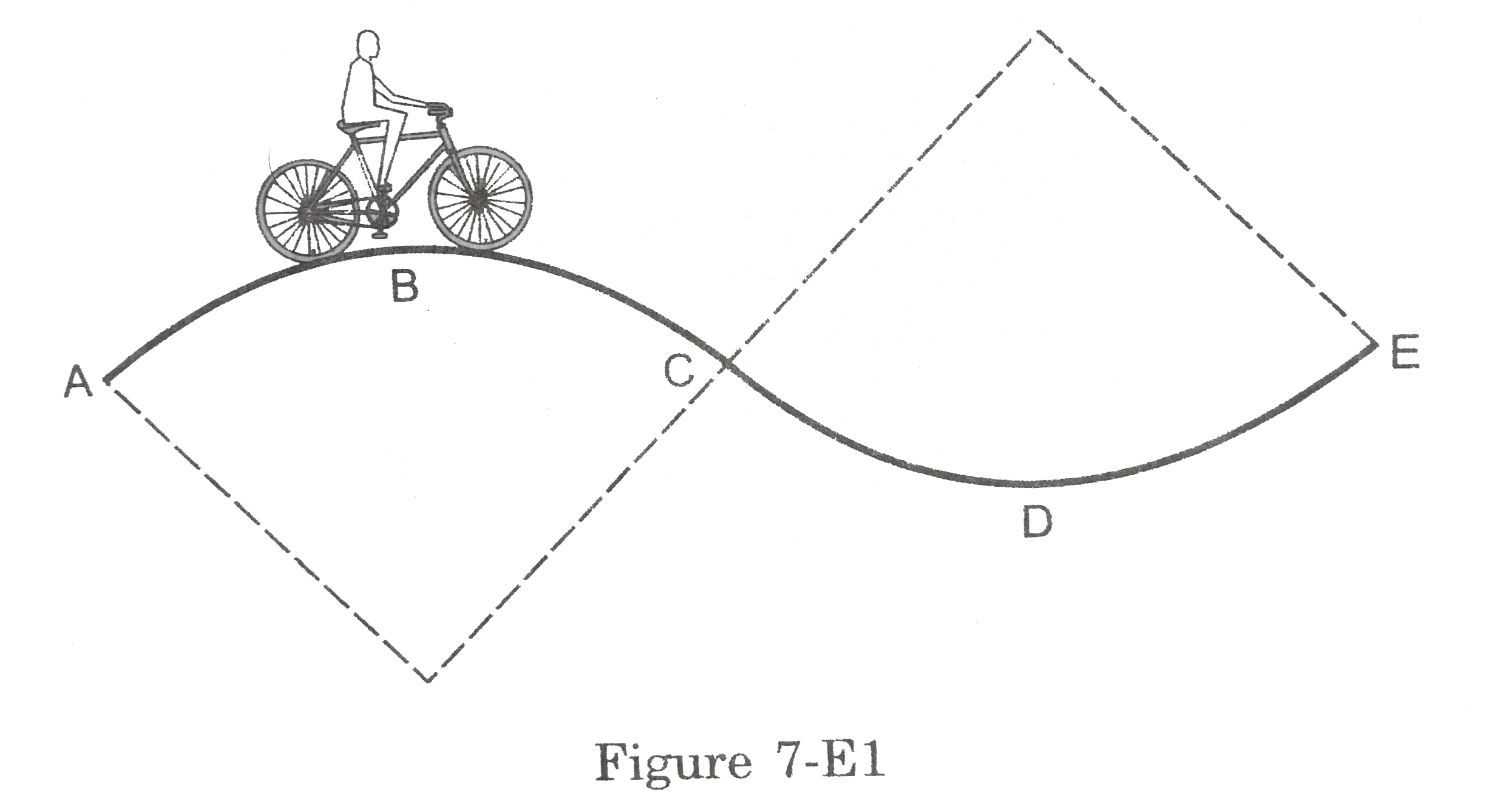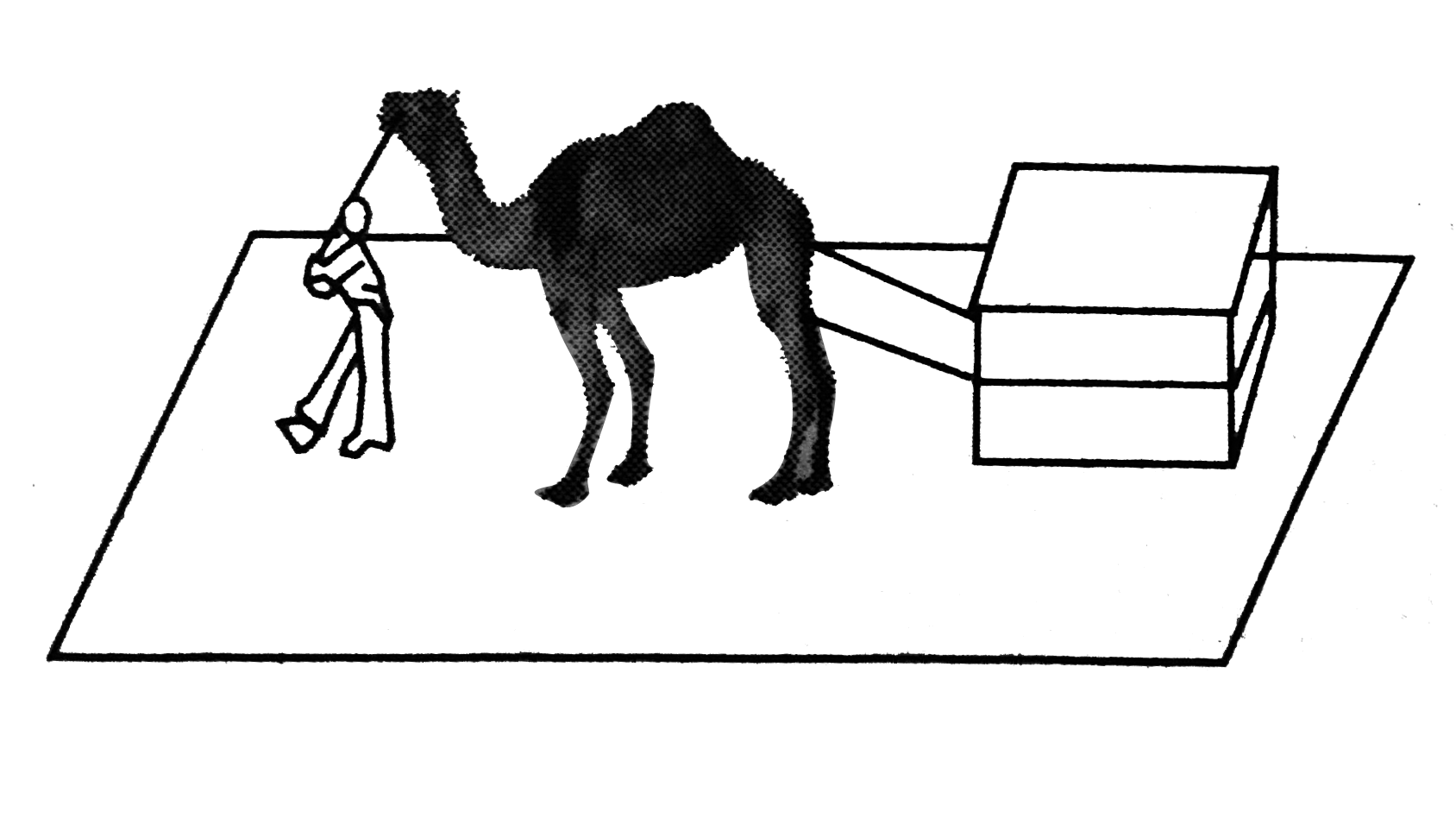The driver of a three wheeler moving with a speed of 36km/h sees a child standing in the middle of the road and brings his vehicle to rest in 4 s just in time to save the child What is the average retarding force on the vehicle ? The mass of three wheeler is 400 kg and mass of the driver is 65 kg.
To solve the problem, we will follow these steps:
Step 1: Convert the speed from km/h to m/s
The initial speed of the three-wheeler is given as 36 km/h. We need to convert this speed into meters per second (m/s).
Speed in m/s=Speed in km/h×518
Speed in m/s=36×518=10m/s
Step 2: Identify the final speed and time
The final speed (v) after the vehicle comes to rest is 0 m/s. The time (t) taken to stop is given as 4 seconds.
Step 3: Calculate the acceleration
Using the equation of motion:
v=u+at
Where:
- v=0m/s (final speed)
- u=10m/s (initial speed)
- a = acceleration
- t=4s
Rearranging the equation to solve for acceleration (a):
0=10+a×4
a×4=−10
a=−104=−2.5m/s2
Step 4: Calculate the total mass of the system
The total mass (m) of the three-wheeler and the driver is the sum of their individual masses:
- Mass of the three-wheeler = 400 kg
- Mass of the driver = 65 kg
m=400kg+65kg=465kg
Step 5: Calculate the average retarding force
Using Newton's second law, the retarding force (F) can be calculated as:
F=m×a
Substituting the values we have:
F=465kg×(−2.5m/s2)
F=−1162.5N
The negative sign indicates that the force is acting in the opposite direction of the motion (retarding force).
Final Answer
The average retarding force on the vehicle is 1162.5N (acting in the direction opposite to the motion).
---
The initial speed of the three-wheeler is given as 36 km/h. We need to convert this speed into meters per second (m/s).
Speed in m/s=36×518=10m/s
The final speed (v) after the vehicle comes to rest is 0 m/s. The time (t) taken to stop is given as 4 seconds.
Using the equation of motion:
v=u+at
Where:
- v=0m/s (final speed)
- u=10m/s (initial speed)
- a = acceleration
- t=4s
0=10+a×4
a×4=−10
a=−104=−2.5m/s2
The total mass (m) of the three-wheeler and the driver is the sum of their individual masses:
- Mass of the three-wheeler = 400 kg
- Mass of the driver = 65 kg
Using Newton's second law, the retarding force (F) can be calculated as:
F=m×a
Substituting the values we have:
F=465kg×(−2.5m/s2)
F=−1162.5N
The average retarding force on the vehicle is 1162.5N (acting in the direction opposite to the motion).
Topper's Solved these Questions
Similar Questions
An automobile moves on a road with a speed of 54 km/h. The radius of its wheels is 0.35 m. What is the average negative torque transmitted by its brakes to a wheel if the vehicle is brought to rest in 15 s? The moment of inertia of the wheel about its axis of rotation is 3 kg-m2.
View SolutionAn autmobile moves on road with a speed of 54km/h. The radius of its wheel is 0.45m and the moment of inertia of the wheel about its axis of rotation is 3kgm2. If the vehicle is brought to rest in 15s, the magnitude of average torque tansmitted by its brakes to the wheel is :
View SolutionA track consists of two circular pars ABC and CDE of equal radius 100 m and joined smoothly as shown in figure.Each part subtends a right angle at its centre. A cycle weighing 100 kg together with rider travels at a constant speed of 18 km/h on the track. A. Find the normal contact force by the road on the cycle when it is at B and at D. b.Find the force of friction exerted by the track on the tyres when the cycle is at B,C and D. c. Find the normal force between the road and the cycle just before and just after the cycle crosses C. d. What should be the minimum friction coefficient between the road and the tyre, which will ensure that the cyclist can move with constant speed? Take g=10ms2

View SolutionA vehicle of mass 500 kg is moving with a velocity of 15ms−1. It is brought to rest by a retarding force. Find the distance moved by the vehicle before coming to rest, if the sliding friction between the tyres and the road is 3000N.
View SolutionA trolly of mass 200kg moves with a uniform speed of 36 km/h on a frictionless track. A child of mass 20kg runs on the trolly from one end to the other (10m away) with a speed of 4m/s relative to the trolly in a direction opposite to the trolly's motion and jumps out of the trolly. How much has teh trolly moved from the time the child begins to run ?
View SolutionWhile waiting in a car at a signal, an 80 kg man and his car are suddenly accelerated to a speed of 5ms−1 due to a rear-end collision by another vehicle. If the time of impact is 0.4s, the average force on the man is
View SolutionOn complete combustion , a litre of petrol gives off heat equivalent to 3×107J . In a test drive, a car weighing 1200kg, including the mass of driver, runs 15km per litre while moving with a uniform speed on a straight track. Assuming that friction offered by the road surface and air to be uniform, calculate the force of friction acting on the car during the test drive. If the efficiency of the car engine were 0.5.
View SolutionDirection :
Resistive force proportional to object velocity
At low speeds, the resistive force acting on an object that is moving a viscous medium is effectively modeleld as being proportional to the object velocity. The mathematical representation of the resistive force can be expressed as
R=−bv
Where v is the velocity of the object and b is a positive constant that depends onthe properties of the medium and on the shape and dimensions of the object. The negative sign represents the fact that the resistance froce is opposite to the velocity.
Consider a sphere of mass m released frm rest in a liquid. Assuming that the only forces acting on the spheres are the resistive froce R and the weight mg, we can describe its motion using Newton's second law. though the buoyant force is also acting on the submerged object the force is constant and effect of this force be modeled by changing the apparent weight of the sphere by a constant froce, so we can ignore it here.
Thus mg−bv=mdvdt⇒dvdt=g−bmv
Solving the equation
v=mgb(1−e−bt/m)
where e=2.71 is the base of the natural logarithm
The acceleration becomes zero when the increasing resistive force eventually the weight. At this point, the object reaches its terminals speed v1 and then on it continues to move with zero acceleration
mg−bT=0
⇒mT=mgb
Hence v=vT(1−evtm)
In an experimental set-up four objects I,II,III,IV were released in same liquid. Using the data collected for the subsequent motions value of constant b were calculated. Respective data are shown in table.
ObjectIIIIIIVMass (in kg.)1234Constant bin (N-s)/m3.71.41.42.8
If an object of mass 2 kg and constant b=4N−sm has terminal speed vT in a liquid then time required to reach 0.63vT from start of the motion is :
View SolutionDirection :
Resistive force proportional to object velocity
At low speeds, the resistive force acting on an object that is moving a viscous medium is effectively modeleld as being proportional to the object velocity. The mathematical representation of the resistive force can be expressed as
R=−bv
Where v is the velocity of the object and b is a positive constant that depends onthe properties of the medium and on the shape and dimensions of the object. The negative sign represents the fact that the resistance froce is opposite to the velocity.
Consider a sphere of mass m released frm rest in a liquid. Assuming that the only forces acting on the spheres are the resistive froce R and the weight mg, we can describe its motion using Newton's second law. though the buoyant force is also acting on the submerged object the force is constant and effect of this force be modeled by changing the apparent weight of the sphere by a constant froce, so we can ignore it here.
Thus mg−bv=mdvdt⇒dvdt=g−bmv
Solving the equation
v=mgb(1−e−bt/m)
where e=2.71 is the base of the natural logarithm
The acceleration becomes zero when the increasing resistive force eventually the weight. At this point, the object reaches its terminals speed v1 and then on it continues to move with zero acceleration
mg−bT=0
⇒mT=mgb
Hence v=vT(1−evtm)
In an experimental set-up four objects I,II,III,IV were released in same liquid. Using the data collected for the subsequent motions value of constant b were calculated. Respective data are shown in table.
ObjectIIIIIIVMass (in kg.)1234Constant bin (N-s)/m3.71.41.42.8
A small sphere of mass 2.00 g is released from rest in a large vessel filled with oil. The sphere approaches a terminal speed of 10.00 cm/s. Time required to achieve speed 6.32 cm/s from start of the motion is (Take g=10.00m/s2) :
View SolutionRam and Ali have been fast friends since childhood. Ali neglected studies and now has no means to earn money other than a channel whereas Ram has become an engineer. Now both are working in the same factory. Ali uses camel to transport the load within the factory.
 Due to low salary and degradation in health of camel, Ali becomes worried and meets his friend Ram and discusses his problems. Ram collected some data and with some assumptions concluded the following:
Due to low salary and degradation in health of camel, Ali becomes worried and meets his friend Ram and discusses his problems. Ram collected some data and with some assumptions concluded the following:
i. The load used in each trip is 1000kg and has friction coefficient μk=0.1 and μs=0.2.
ii. Mass of camel is 500kg.
iii. Load is accelerated for first 50m with constant acceleration, then it is pulled at a constant speed of 5ms−1 for 2km and at last stopped with constant retardation in 50m.
iv. From biological data, the rate of consumption of energy of camel can be expressed as P=18×103v+104Js−1 where P is the power and v is the velocity of the camel. After calculations on different issues, Ram suggested proper food, speed of camel, etc. to his friend. For the welfare of Ali, Ram wrote a letter to the management to increase his salary.
(Assuming that the camel exerts a horizontal force on the load):
The ratio of the energy consumed by the camel during uniform motion for the two cases when it moves with speed 5ms−1 to the case when it moves with 10ms−1
View Solution
